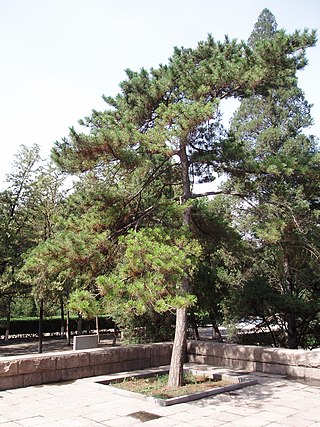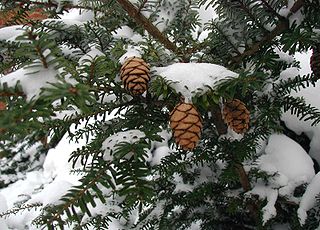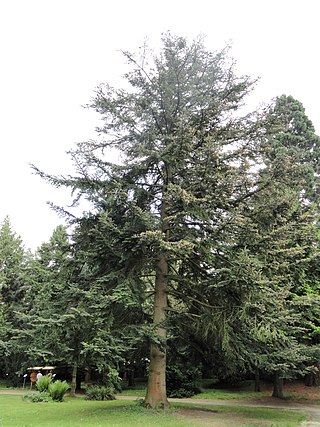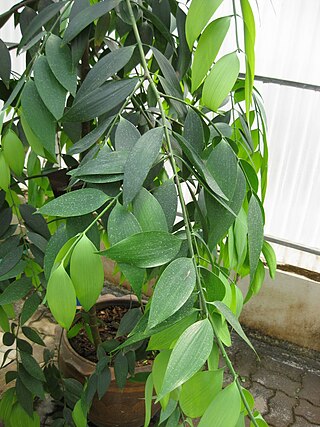
Tsuga is a genus of conifers in the subfamily Abietoideae of Pinaceae, the pine family. The English-language common name "hemlock" arose from a perceived similarity in the smell of its crushed foliage to that of the unrelated plant hemlock. Unlike the latter, Tsuga species are not poisonous.

Pinus tabuliformis, also called Chinese red pine, Manchurian red pine, or Southern Chinese pine is a pine native to northern China and northern Korea.

Tsuga mertensiana, known as mountain hemlock, is a species of hemlock native to the west coast of North America, found between Southcentral Alaska and south-central California.

Keteleeria davidiana is a coniferous evergreen tree native to Taiwan and southeast China, in the provinces of Gansu, Guangxi, Guizhou, Hubei, Hunan, Shaanxi, Sichuan, and Yunnan. It also occurs in the very northern part of Vietnam. The tree is restricted to hills, mountains, and valleys at elevations of 200–1500 m. Generally, it grows in regions with a more continental climate than the other two Keteleeria species.

Juniperus squamata, the flaky juniper, or Himalayan juniper is a species of coniferous shrub in the cypress family Cupressaceae, native to the Himalayas and China.

Larix griffithii, the Sikkim larch, is a species of larch, native to the eastern Himalaya in eastern Nepal, Sikkim, western Bhutan and southwestern China, growing at 1,800–4,100 metres (5,900–13,500 ft) in altitude.

Juniperus deppeana is a small to medium-sized tree reaching 10–15 metres in height. It is native to central and northern Mexico and the southwestern United States.

Juniperus flaccida is a large shrub or small tree reaching 5–10 metres tall. It is native to central and northern Mexico and the extreme southwest of Texas, United States. It grows at moderate altitudes of 800–2,600 metres, on dry soils.

Pinus massoniana is a species of pine, native to Taiwan, a wide area of central and southern China, and northern Vietnam.

Taxus wallichiana, the Himalayan yew, is a species of yew, native to the Himalaya and parts of south-east Asia. The species has a variety of uses in traditional medicine. It is currently classified as endangered by the IUCN.

Calocedrus formosana is a conifer endemic to Taiwan.

Calocedrus macrolepis, commonly known as Chinese incense-cedar; is a species of conifer native to southwest China, northern Vietnam, northern Laos, extreme northern Thailand and northeastern Myanmar.

Tsuga diversifolia, commonly known as northern Japanese hemlock, is a species of conifer native to the Japanese islands of Honshū, Kyūshū, and Shikoku. In Europe and North America, the species is sometimes employed as tree for the garden and has been in cultivation since 1861.

Tsuga sieboldii, also called the southern Japanese hemlock, or in Japanese, simply tsuga (栂), is a conifer native to the Japanese islands of Honshū, Kyūshū, Shikoku and Yakushima. In Europe and North America the tree is sometimes used as an ornamental and has been in cultivation since 1861.

Tsuga dumosa, commonly called the Himalayan hemlock or in Chinese, Yunnan tieshan, is a species of conifer native to the eastern Himalayas. It occurs in parts of Nepal, India, Bhutan, Myanmar, Vietnam and Tibet. Within its native range the tree is used for construction as well as for furniture. In Europe and North America, it is occasionally encountered as an ornamental species and was first brought to the United Kingdom in 1838.

Abies chensiensis, the Shensi fir, is a fir native to Gansu, Hubei, Sichuan, Tibet, Yunnan in China, and Arunachal Pradesh in India. It was first described by Philippe Édouard Léon Van Tieghem in 1892.

Chamaecyparis formosensis is a species of Chamaecyparis, endemic to Taiwan, where it grows in the central mountains at moderate to high altitudes of 1000–2900 m. It is threatened by habitat loss and over-cutting for its valuable timber.

Juniperus monosperma is a species of juniper native to western North America, in the United States in Arizona, New Mexico, southern Colorado, western Oklahoma (Panhandle), and western Texas, and in Mexico in the extreme north of Chihuahua. It grows at 970–2300 m altitude.

Nageia wallichiana is a species of conifer in the family Podocarpaceae. It is a tree 10–54 m high, found in Brunei, Cambodia, China, India, Indonesia, Laos, Malaysia, Myanmar, Thailand, and Vietnam. Nageia wallichiana is the most widely distributed species among the seven species in the genus Nageia. If the land areas of China and Japan are excluded, its distribution nearly coincides with that of the genus and includes both the western outliers in India and the easternmost part on Normanby Island. It is one of the most extensive conifer ranges recognized and is similar to Dacrycarpus imbricatus and Podocarpus neriifolius.

Pinus armandii var. mastersiana, also known by the common names of the Taiwan high mountain pine, Taiwan mountain pine, or Masters' pine, is a rare variety of Pinus armandii in the family Pinaceae that is endemic to portions of northern and central Taiwan.





















